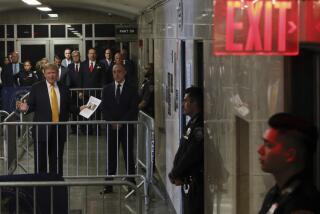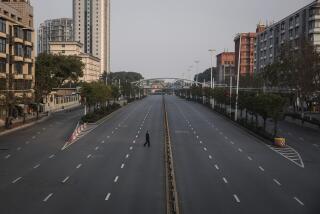Anthrax findings get mixed reaction
- Share via
WASHINGTON — The Justice Department couldn’t prosecute the man it believes was responsible for the anthrax attacks that spread fear across the nation in 2001. So on Wednesday, federal officials took the risky and virtually unprecedented step of trying their top-secret case in the court of public opinion.
And though the verdict was mixed, many of those privy to mountains of new details released by federal authorities said they were convinced that the government had found the culprit in Bruce E. Ivins, the troubled government scientist who apparently killed himself last week as authorities closed in on him.
“As far as I am considered, they have solved it,” said Maureen Stevens, the widow of Robert Stevens, a Florida photo editor who was the first victim of the anthrax attacks. “I thought that they seemed to have this all wrapped up.”
Stevens was among a large group of victims’ relatives and attack survivors who were flown to Washington from around the country Tuesday, sheltered in a downtown hotel and then taken by van to FBI headquarters Wednesday for a private three-hour briefing by FBI agents, U.S. postal inspectors and prosecutors.
During a multimedia presentation in a packed conference room, FBI Director Robert S. Mueller III and others acknowledged that most of the evidence was circumstantial, Stevens and others said.
“But all together, there is so much of it,” Stevens said of the information presented. “Most of us were thinking that this was it, finally, after a long, long seven years.”
However, the anthrax attacks were so unsettling and the investigation so controversial that the FBI, postal inspectors and Justice Department may never succeed in convincing the nation that the long mystery is solved.
FBI and Justice Department officials said they were not aware of another case in which federal authorities, denied the opportunity to file imminent criminal charges, sought permission from a federal judge to unseal the investigative evidence to convince the American public of the merits of their case.
But that’s what happened Wednesday, capping a fast-paced series of events that started July 29 when Ivins died of an apparent overdose of over-the-counter drugs.
The Times reported in the following days that the Justice Department was on the verge of charging him as the sole perpetrator of the attacks.
“Ordinarily, we do not publicly disclose evidence against a suspect who has not been charged, in part because of the presumption of innocence,” Jeffrey A. Taylor, U.S. attorney for the District of Columbia, said at a televised news conference from Justice Department headquarters.
“But because of the extraordinary and justified public interest in this investigation . . . today we are compelled to take the extraordinary step” of going public, he said.
Taylor and Joseph Persichini Jr., an assistant FBI director, summarized the evidence they said would have established Ivins’ guilt “beyond a reasonable doubt.”
Federal authorities also gave members of Congress an in-depth briefing on the anthrax investigation, which Taylor said would be shut down in a matter of weeks and considered solved.
Some victims said they were skeptical of the findings presented Wednesday.
“There’s too many things left out. I’m not even close to being convinced,” said David R. Hose Sr., who was infected while working in the State Department mail room. He did not attend the briefing but said he read many of the documents posted online.
A veteran criminal defense lawyer said he was doubtful about the case against Ivins because the evidence will not face a court test.
“Remember Richard Jewell,” said John Wesley Hall Jr., the Arkansas-based president of the National Assn. of Criminal Defense Lawyers, referring to the security guard who was wrongly accused of planting a bomb at the 1996 Summer Olympics in Atlanta. “On the surface, this looks like a convincing case, but I have no confidence in the FBI.”
Martin E. Hugh-Jones, an anthrax expert and longtime colleague of Ivins, said the FBI’s scientific evidence seemed thin, in part because the bureau did not apply the rigorous tests employed by scientists checking their own hypotheses for weaknesses.
Critics also included members of Congress who faulted the FBI for a case that appeared to take so many wrong turns, even as agents conducted 9,100 interviews on six continents, reviewed 26,000 e-mails, conducted 75 searches and analyzed 4 million megabytes of computer memory.
Rep. Rush Holt Jr. (D-N.J.), a physicist who represents the district from which the anthrax letters were mailed, was privately briefed by Mueller. He said he intended to hold hearings to pursue outstanding questions such as why the bureau focused for several years almost entirely on another scientist at the U.S. biowarfare lab where Ivins worked, Steven J. Hatfill.
“While the circumstantial evidence pointing to Dr. Ivins that the Department of Justice released today is compelling, a number of important questions remain unanswered, such as why investigators remained focused on Dr. Hatfill long after they had begun to suspect Dr. Ivins of the crime and why investigators are so certain that Ivins acted alone,” Holt said.
Sen. Charles Grassley (R-Iowa) called for a “full-blown accounting” of the inquiry.
But by day’s end, the verdict among many connected to the case from the start appeared to lean in the government’s favor.
“We feel at ease,” said Ramesh Patel, whose wife, Jyotsna, was one of several New Jersey postal workers who were infected with anthrax but survived. “It looks like all roads lead to Dr. Ivins.”
Ernesto Blanco, an anthrax survivor who traveled from Palm Beach, Fla., also said that he was convinced the government had identified the right person and that no other suspects were involved.
“It’s over,” he said. “Today convinced me.”
--
josh meyer@latimes.com
Times staff writers Stephen Braun, Chuck Neubauer, Charles Piller, David Savage, Vimal Patel and Cynthia Dizikes contributed to this report.
More to Read
Sign up for Essential California
The most important California stories and recommendations in your inbox every morning.
You may occasionally receive promotional content from the Los Angeles Times.













